2003 GMC SIERRA DENALI child seat
[x] Cancel search: child seatPage 60 of 428
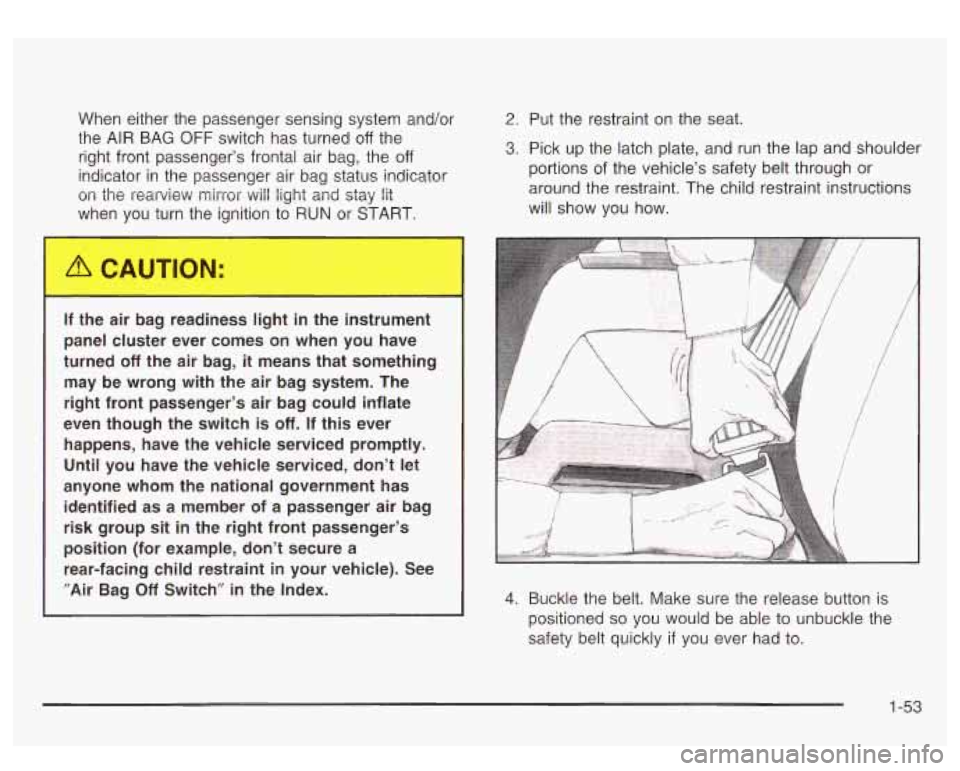
When either the passenger sensing system and/or
the AIR BAG
OFF switch has turned off the
right front passenger’s frontal air bag, the
off
indicator in the passenger air bag status indicator
on the rearview mirror will light and stay lit
when
y-” turn the ignition to RUN or START.
2. Put the restraint on the seat.
3. Pick up the latch plate, and run the lap and shoulder
portions
of the vehicle’s safety belt through or
around the restraint. The child restraint instructions
will show you how.
If the air bag readiness light
in the instrument
panel cluster ever comes
on when you have
turned
off the air bag, it means that something
may be wrong with the air bag system. The
right front passenger’s air bag could inflate
even though the switch
is off. If this ever
happens, have the vehicle serviced promptly.
Until
you have the vehicle serviced, don’t let
anyone whom the national government has identified as a member of a passenger air bag
risk group sit in the right front passenger’s
position (for example, don’t secure a
rear-facing child restraint
in your vehicle). See
”Air Bag
Off Switch” in the Index. 4. Buckle the belt. Make sure the release button is
positioned
so you would be able to unbuckle the
safety belt quickly
if you ever had to.
1-53
Page 62 of 428
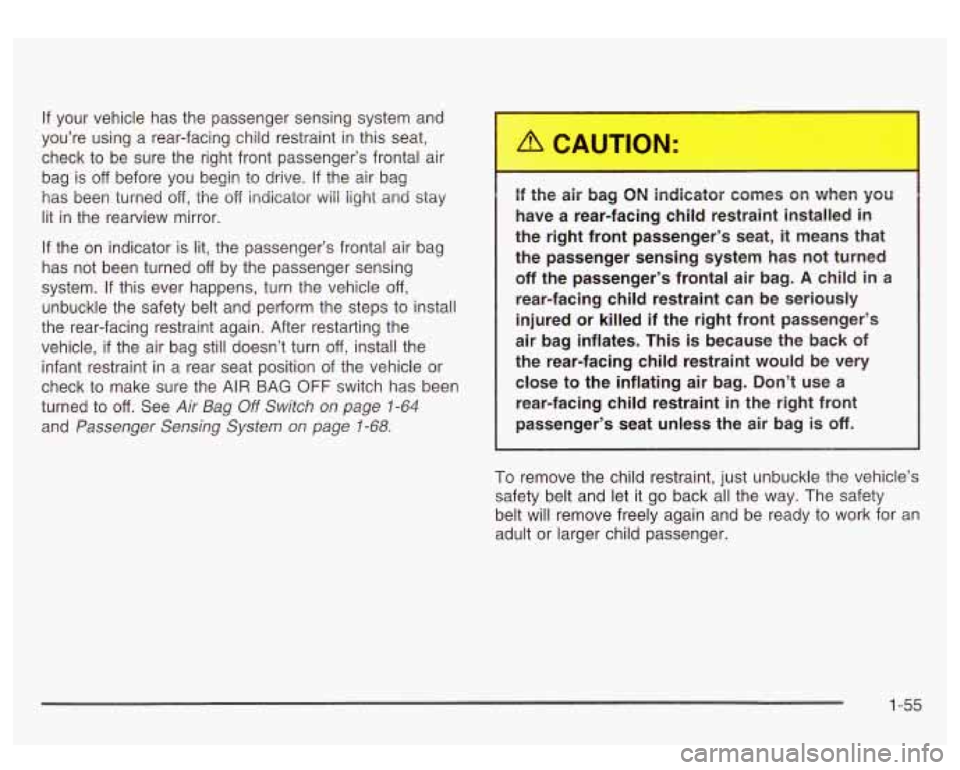
if your vehicle has the passenger sensing system and
you’re using a rear-facing child restraint in this seat,
check to be sure the right front passenger’s frontal air
bag is
off before you begin to drive. If the air bag
has been turned
off, the off indicator wiii iight and stay
lit in the rearview mirror.
If the on indicator is lit, the passenger’s frontal air bag
has not been turned
off by the passenger sensing
system. If this ever happens, turn the vehicle
off,
unbuckle the safety belt and perform the steps to install
the rear-facing restraint again. After restarting the
vehicle,
if the air bag still doesn’t turn off, install the
infant restraint in a rear seat position of the vehicle or
check to make sure the AIR
BAG OFF switch has been
turned to
off. See Air Bag Off Switch on page 1-64
and Passenger Sensing System on page 1-68.
If the air bag ON indicator comes on when you
have a rear-facing child restraint installed in
the right front passenger’s seat, it means that
the passenger sensing system has not turned
off the passenger’s frontal air bag. A child in a
rear-facing child restraint can be seriously
injured or killed if the right front passenger’s
air bag inflates. This
is because the back of
the rear-facing child restraint would be very close to the inflating air bag. Don’t use a
rear-facing child restraint
in the right front
passenger’s seat unless the air bag
is off.
To remove the child restraint, just unbuckle the vehicle’s
safety belt and let it go back all the way. The safety
belt will remove freely again and be ready to work for an
adult or larger child passenger.
1-55
Page 73 of 428
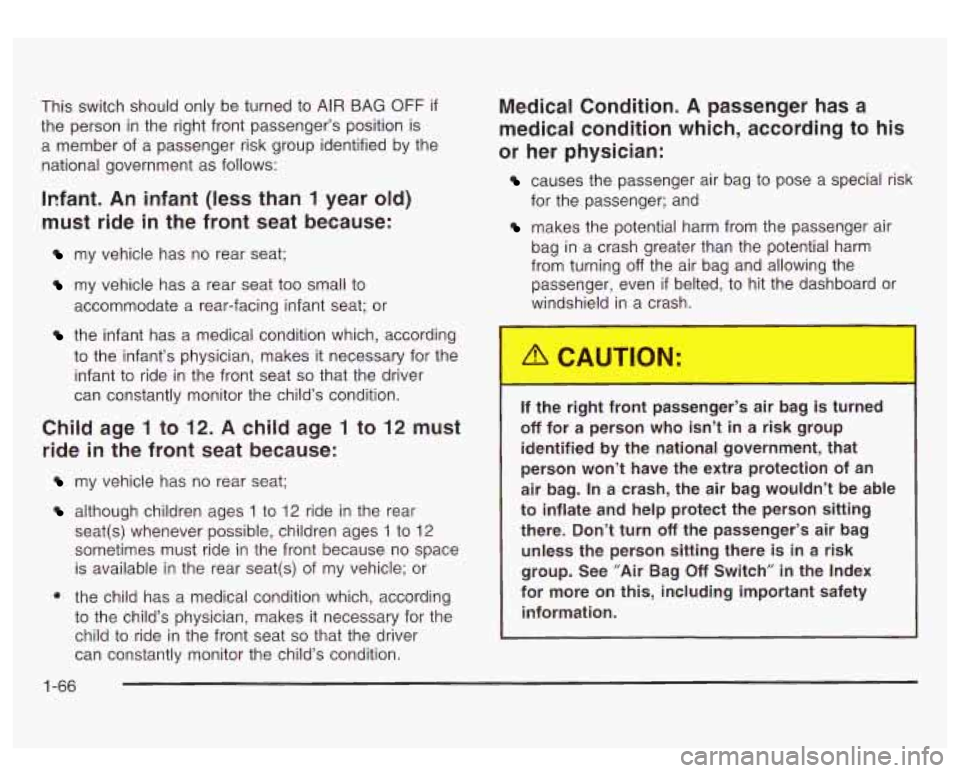
This switch should only be turned to AIR BAG OFF if
the person in the right front passenger’s position is
a member of a passenger risk group identified by the
national government as follows:
Infant. An infant (less than 1 year old)
must ride in the front seat because:
my vehicle has no rear seat;
my vehicle has a rear seat too small to
accommodate a rear-facing infant seat; or
the infant has a medical condition which, according
to the infant’s physician, makes it necessary for the
infant to ride in the front seat
so that the driver
can constantly monitor the child’s condition.
Child age 1 to 12. A child age 1 to 12 must
ride in the front seat because:
my vehicle has no rear seat;
although children ages 1 to 12 ride in the rear
seat(s) whenever possible, children ages
1 to 12
sometimes must ride in the front because no space
is available in the rear seat(s) of my vehicle; or
0 the child has a medical condition which, according
to the child’s physician, makes it necessary for the
child to ride in the front seat
so that the driver
can constantly monitor the child’s condition.
1-66
Medical Condition. A passenger has a
medical condition which, according to his
or her physician:
causes the passenger air bag to pose a special risk
for the passenger; and
makes the potential harm from the passenger air
bag in a crash greater than the potential harm
from turning
off the air bag and allowing the
passenger, even
if belted, to hit the dashboard or
windshie in a crash.
11 tne right front passenger’s air bag is -_-me_.
off for a person who isn’t in a risk group
identified by the national government, that
person won’t have the extra protection of an
air bag. In a crash, the air bag wouldn’t be able
to inflate and help protect the person sitting
there. Don’t turn
off the passenger’s air bag
unless the person sitting there is in a risk
group. See ”Air Bag
Off Switch” in the Index
for more on this, including important safety
information.
Page 76 of 428

Passenger Air Bag
Status
Indicator
- Canada
The passenger sensing system will turn
off the right
front passenger’s frontal air bag under certain
conditions. The driver’s air bag and the side air bags
are not part of the passenger sensing system. In
addition to the passenger sensing system, your vehicle
also has an air bag
off switch located on the instrument
panel as required by the government.
The passenger sensing system works with sensors that
are part of the right front passenger’s seat and safety
belt. The sensors are designed to detect the presence of
a properly seated occupant and determine
if the
passenger’s frontal air bag should be enabled (may
inflate) or not. The passenger
sensing system is designed to turn
oft
the right front passenger’s frontal air bag if:
the right front passenger seat is unoccupied
the system determines that an infant is present in a
rear-facing infant seat
J the system determines that a small child is present
in a forward-facing child restraint
the system determines that a small child is present
in a booster seat,
0 a right front passenger takes hidher weight off of
the seat for a period of time
the right front passenger seat is occupied by a
smaller person, such as a child who has outgrown
child restraints or a very small person
the air bag off switch is in the off position
or if there is a critical problem with the air bag
system or the passenger sensing system
When the passenger’s frontal air bag has been turned
off either by the passenger sensing system or by the air
bag
off switch, the off indicator will light and stay lit to
remind you that the air bag is
off.
1-69
Page 77 of 428
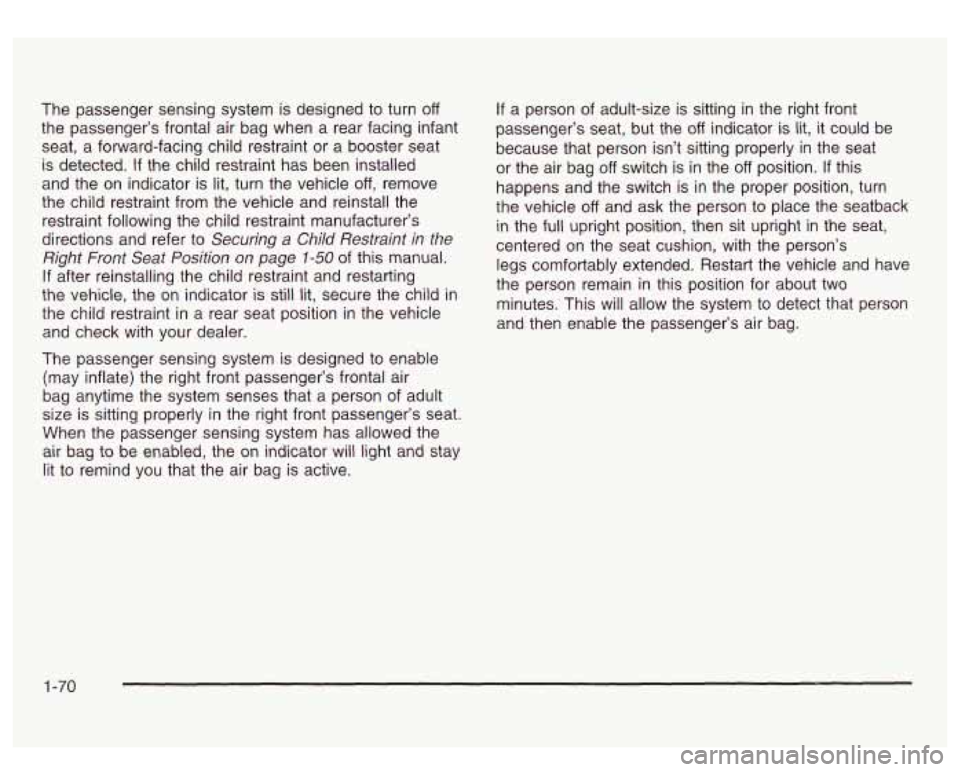
The passenger sensing system is designed to turn off
the passenger’s frontal air bag when a rear facing infant
seat, a forward-facing child restraint or a booster seat
is detected.
If the child restraint has been installed
and the on indicator is lit, turn the vehicle
off, remove
the child restraint from the vehicle and reinstall the
restraint following the child restraint manufacturer’s
directions and refer to
Securing a Child Restraint in the
Right Front Seat Position
on page 1-50 of this manual.
If after reinstalling the child restraint and restarting
the vehicle, the on indicator is still lit, secure the child in
the child restraint in a rear seat position in the vehicle
and check with your dealer.
The passenger sensing system is designed to enable
(may inflate) the right front passenger’s frontal air
bag anytime the system senses that
a person of adult
size is sitting properly in the right front passenger’s seat.
When the passenger sensing system has allowed the
air bag to be enabled, the on indicator will light and stay
lit to remind you that the air bag is active.
If a person of adult-size is sitting in the right front
passenger’s seat, but the
off indicator is lit, it could be
because that person isn’t sitting properly in the seat
or the air bag
off switch is in the off position. If this
happens and the switch is in the proper position, turn
the vehicle
off and ask the person to place the seatback
in the full upright position, then sit upright in the seat,
centered on the seat cushion, with the person’s
legs comfortably extended. Restart the vehicle and have
the person remain in this position for about two
minutes. This will allow the system to detect that person
and then enable the passenger’s air bag.
1-70
Page 156 of 428
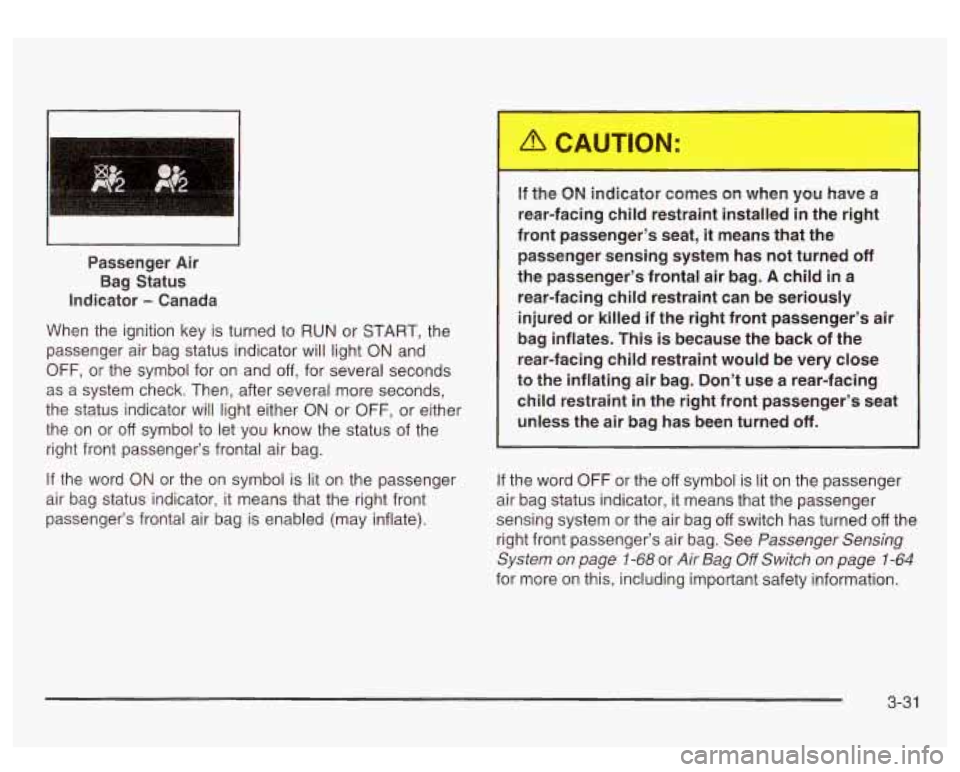
~~ ~~ Passenger
Air
Bag Status
Indicator
- Canada
When the ignition key is turned to RUN or START, the
passenger air bag status indicator will light ON and
OFF, or the symbol for on and off, for several seconds
as a system check. Then, after several more seconds,
the status indicator will light either ON or OFF, or either
the on or
off symbol to let you know the status of the
right front passenger’s frontal air bag.
If the word ON or the on symbol is lit on the passenger
air bag status indicator, it means that the right front
passenger’s frontal air bag is enabled (may inflate). If the
ON indicator comes on when you have a
rear-facing child restraint installed
in the right
front passenger’s seat, it means that the
passenger sensing system has not turned
off
the passenger’s frontal air bag. A child in a
rear-facing child restraint can be seriously
injured or killed if the right front passenger’s air
bag inflates. This is because the back of the
rear-facing child restraint would be very close
to the inflating air bag. Don’t use a rear-facing
child restraint in the right front passenger’s seat unless the air bag has been turned
off.
If the word OFF or the off symbol is lit on the passenger
air bag status indicator, it means that the passenger
sensing system or the air bag
off switch has turned off the
right front passenger’s air bag. See
Passenger Sensing
System on page
1-68 or Air Bag Off Switch on page 1-64
for more on this, including important safety information.
3-3 1
Page 256 of 428

Th.,,ds yo^ pur inside your vehicle can strike
and injure people in a sudden stop or turn, or
in a crash.
Put things in the trunk of your vehicle. In a
trunk, put them
as far forward as you can.
Try to spread the weight evenly.
Never stack heavier things, like suitcases,
inside the vehicle
so that some of them
are above the tops of the seats.
Don’t leave an unsecured child restraint in
your vehicle.
When you carry something inside the
vehicle, secure it whenever you can.
There’s also important loading information for off-road
driving in this manual. See “Loading Your Vehicle
for Off-Road Driving“ under
Operating Your
All- Wheel-Drive Vehicle Off Paved Roads on page 4- 16.
Payload
Payload capacity is the maximum load capacity that your
vehicle can carry. Be sure to include the weight of the
occupants as part of your load.
If you added any accessories or
equipment after your vehicle left the
factory, remember to subtract the weight of these things
from the payload. Your dealer can help you with this.
Remember not to exceed the Gross Axle Weight Rating
(GAWR) of the front or rear axle.
Two-Tiered Loading
By positioning four 2’’ x 6’’ wooden planks across the
width of the pickup box, you can create an upper
load platform. The planks must be inserted in the pickup
box depressions. The length of the planks must allow
for at least a
3/4 inch (2 cm) bearing surface on
each end of the plank.
When using this upper load platform, be sure the load is
securely tied down to prevent it from shifting. The
load’s center of gravity should be positioned in a zone
over the rear axle. The zone is located in the area
between the front of each wheel well and the rear of
each wheel well. The center of gravity height must not
extend above the top of the pickup box flareboard.
Any load that extends beyond the vehicle’s taillamp area
must be properly marked according to local laws and
regulations.
Remember not to exceed the Gross Axle Weight Rating
(GAWR) of the front or rear axle.
4-47
Page 408 of 428
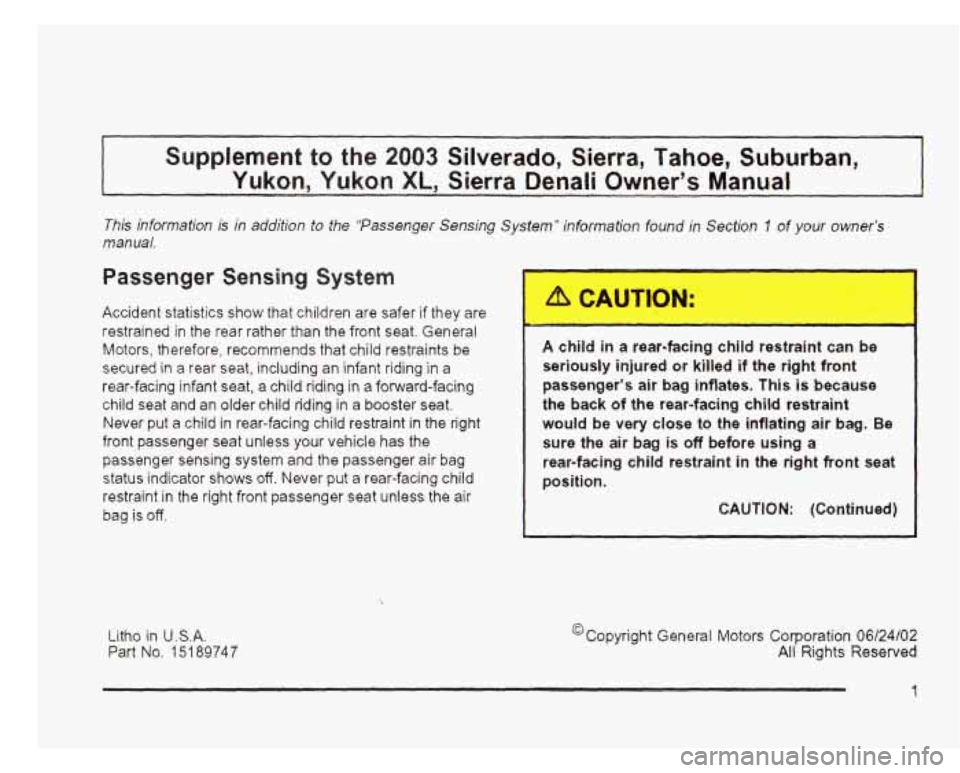
Supplement to the 2003 Silverado, Sierra, Tahoe, Suburban,
r’s Manual
Passenger Sensing System
Accident statistics show that children are safer if they are I
restrained in the rear rather than the front seat. General
Motors, therefore, recommends that child restraints be
secured in
a rear seat, including an infant riding in a
rear-facing infant seat,
a child riding in a forward-facing
child seat and an older child riding in a booster seat.
Never put a child in rear-facing child restraint in the tight
front passenger seat unless your vehicle has the
passenger sensing system and the passenger air bag
status indicator
shows off. Never put a rear-facing child
restraint in the right front passenger seat unless the air
bag
is off.
A child in a rear-facing child restraint can be
seriously injured or killed
if the right front
passenger’s air bag inflates. This
is because
the back
of the rear-facing child restraint
would be very close to the inflating air bag.
Be
sure the air bag is off before using a
rear-facing child restraint in the right front seat
position.
CAUTION: (Continued)
Litho in
U.S.A.
Part No. 15189747 ‘Copyright General Motors
Corporation
06/24/02
All Rights Reserved